
17/11/2016 ............ KOS Long Weekend in Dumfries and Galloway - November 2016
Our long weekend in Scotland began in the traditional KOS manner with an early morning stop at the excellent Tebay Services 92 miles up the M6 from Knutsford. The weather had been pretty good up until then but it began to rain heavily as we headed further north making driving conditions very challenging and it was a relief to eventually turn off the motorway and head west along the A75 to our first birding spot of the weekend, the RSPB reserve at Mersehead. 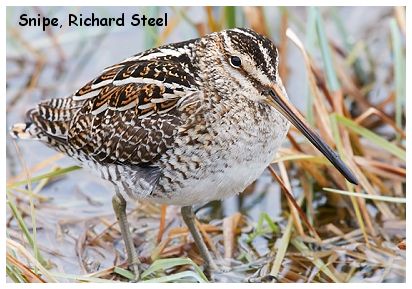 We were greeted by Mike, one of the volunteer wardens, who gave us an excellent introduction to this little piece of Scotland in the comfort of an excellent visitor centre which was located in a nicely converted traditional stone cottage complete with toilets and a conservatory equipped with basic snacks and brewing facilities, rather like those at Burton Wetlands that we've become familiar with since it was extended. We were greeted by Mike, one of the volunteer wardens, who gave us an excellent introduction to this little piece of Scotland in the comfort of an excellent visitor centre which was located in a nicely converted traditional stone cottage complete with toilets and a conservatory equipped with basic snacks and brewing facilities, rather like those at Burton Wetlands that we've become familiar with since it was extended.
We set off along the 3.2km wetland trail to the first of two hides, along a well used path with high hedges either side and home to Goldfinches, Greenfinches, House Sparrows and even some Yellowhammers; in the rough fields behind the hedges around 2,500 Barnacle Geese carefully watched us pass by - lots of chatter amongst the flock but they must have decided that we didn't pose any sort of threat and continues grazing. The hide overlooked large areas of swampy juncus reed beds and pools which held big flocks of wildfowl including large numbers of Pintail, Shoveler and Wigeon plus lesser counts of Mallard and Tufted Duck with three Goldeneye and a single Pochard. Surprisingly we saw few Lapwings but at least 80 Snipe were busy feeding at the waters edge, giving excellent views through the 'scope as the sun briefly appeared. Nothing of much interest at the far hide, just a Dabchick to add to the species list so we made our way back to the car park through another heavy shower before heading for our accommodation at the Premier Inn in Collin near Dumfries.
Organising KOS long weekends has been likened to trying to knit fog but, in the recent past, it's been made more manageable by using Premier Inns (I'm sure other such chains are available). The main advantage is that the organiser can simply say "on such and such a weekend we will be visiting a certain location staying overnight at a given Premier Inn - if you intend to come along let me know and book yourself in online". Simple and it works! The Collin establishment was one of the best we've used with the bonus of individual freshly cooked breakfasts to order rather than a buffet style offering.Day #2 (Friday 18th) found us driving down to the RSPB's Ken-Dee marshes, there's a small car park with an information board at the entrance to the reserve where a trail of about 2K leads down to the Beeches hide. Clouds were building up once again so we decided to drive down to the hide as at least one of our number wouldn't have appreciated a 4K walk in the rain! A young man we met had taken an hour off work to search for the reserve's Willow Tits, apparently it's one of the few places in Scotland where you can see them. 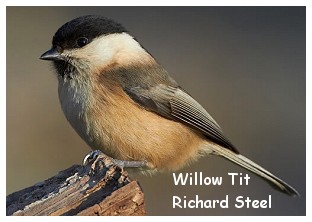 He was lucky as there was a well stocked feeding station outside the hide and within a few minutes two birds appeared, so he returned to work a happy chap! We managed to add a few woodland species to the trip list and on the water in front of us three Goosanders floated past in line astern but no sign of the Greenland White-fronted Geese that we'd hoped to see during our visit. He was lucky as there was a well stocked feeding station outside the hide and within a few minutes two birds appeared, so he returned to work a happy chap! We managed to add a few woodland species to the trip list and on the water in front of us three Goosanders floated past in line astern but no sign of the Greenland White-fronted Geese that we'd hoped to see during our visit. 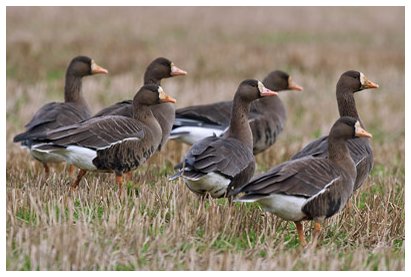 On returning to the car park we set up the 'scope and gave the area a good coat of looking at, there were plenty of Greylags, 100's in fact, plus four Whooper Swans in the distance, eventually patience paid off and we found two White-fronts grazing on a field, even further away than the Swans, we'd never had found them without the 'scope - thanks Derek!! On returning to the car park we set up the 'scope and gave the area a good coat of looking at, there were plenty of Greylags, 100's in fact, plus four Whooper Swans in the distance, eventually patience paid off and we found two White-fronts grazing on a field, even further away than the Swans, we'd never had found them without the 'scope - thanks Derek!! We spent a couple of hours during the afternoon at Bellymack Hill Farm where the owners have set up their Red Kite feeding station. It's a fiver to get in (free for under 16's) 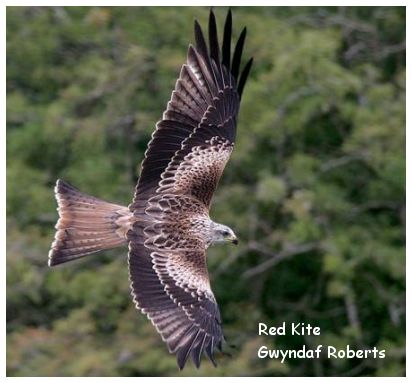 but probably worth it as you can sit inside if it's raining, have a cup of tea and perhaps a bit of homemade cake! The birds are fed at 2pm and begin to gather in numbers during the hour before kickoff at which time a wheelbarrow containing offal is pushed into view and the contents scattered on the grass in front of the centre and on a table about 30 yards away from the audience. The food that's placed on the grass is taken almost immediately in an initial frenzy of activity but, for some reason, that on the table remains untouched for a considerable time. On this occasion it took about 50' before the braver birds finally swooped down from the surrounding trees and began dislodging the food, immediately prompting a second period of activity - click here for a video I took of this. but probably worth it as you can sit inside if it's raining, have a cup of tea and perhaps a bit of homemade cake! The birds are fed at 2pm and begin to gather in numbers during the hour before kickoff at which time a wheelbarrow containing offal is pushed into view and the contents scattered on the grass in front of the centre and on a table about 30 yards away from the audience. The food that's placed on the grass is taken almost immediately in an initial frenzy of activity but, for some reason, that on the table remains untouched for a considerable time. On this occasion it took about 50' before the braver birds finally swooped down from the surrounding trees and began dislodging the food, immediately prompting a second period of activity - click here for a video I took of this. Day#3 19th November 2016 - a nice start to the day with clear blue skies and a temperature of -4
°
C after a sharp overnight frost, we even managed to add a new species to the list from the breakfast table when a small flock of Siskins flew into a group of Silver Birch trees, just outside the window - a good omen.
We spent the whole day at the WWT Caerlaverock reserve, a place I'd not visited since the early days of the society in 1974; it's changed a bit! the society in 1974; it's changed a bit!
In 1948 there were just 300 Barnacle Geese on the reserve, on the day we visited there were 10,000 down from their Svalbard breeding grounds and what a spectacle when the whole lot took to the air at the same time as a light aircraft flew over (much to the annoyance of the warden). We started at the Farmhouse Tower which gave panoramic views over the reserve allowing us to get our bearings as we intended to visit all of the nine hides during the course of the day. The wildfowl are fed twice, at 11:00am and 2pm, so we made our way to the Peter Scott observatory for the first of these. The reserve manager gave an introduction before moving outside with a wheelbarrow full of grain to scatter to the assembled multitude waiting patiently the other side of the glass - click here for video - there were 143 Whooper Swans, Canada Geese, Wigeon, Tufted Ducks, Mallard and even a juvenile Greater Scaup showing well in bright sunlight. After a coffee in the visitor centre we moved to the Saltcot merse observatory where Black-tailed Godwit was ticked off on the list as well as a couple of Little Egrets - they seem to be spreading even further and further north at a great rate of knots!. Shortly before moving off the Hon. Treasurer found us a nice adult male Hen Harrier quartering the marsh in the distance - his bird of the day and we couldn't argue with that. The track to the Avenue tower yielded some list fillers like Great Spotted Woodpecker, Sparrowhawk, Goldcrest and Treecreeper with a Stonechat from the tower itself. This old-style facility didn't make for easy viewing with very narrow viewing slots placed about 5' in the air and matching wooden seats set at an appropriate height 3' above the concrete floor - not very user friendly - a real blast from the past. 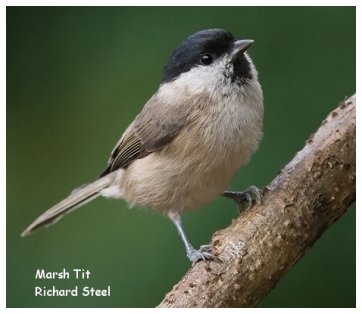 Our final bird, seen from the Folly pond pool was a Green-winged Teal - species number 71 for the trip so far. Our final bird, seen from the Folly pond pool was a Green-winged Teal - species number 71 for the trip so far. We'd decided beforehand that on the Sunday (20th November) we'd head south after breakfast as far as Leighton Moss making for an easier drive later in the day - from Lancashire to home rather than from Dumfries. We headed south after another frosty night, over the top of Shap where the overnight snow lay right up to the side of the road. I'd been told that the Bearded Tits were showing well on the reserve next to the path down to the public hide but they failed to appear, nevertheless we did hear any number of Water Rails calling and at one point we had a sudden burst of song from a well-hidden Cetti's Warbler. From the top of the sky tower a Marsh Harrier showed nicely and on the walk down to the old hides a family of Marsh Tits performed well, feeding on seed left for them in the fallen logs right next to the path. Species number 79 for the weekend - not bad given the conditions, hard won but we had the right team for the job!!
Magpie, Long-tailed Tit, Water Rail, Cetti's Warbler, Marsh Harrier, Marsh Tit, Lesser Black-backed Gull, Black-tailed Godwit, Siskin, Canada Goose, Curlew, Little Egret, Great Spotted Woodpecker, Moorhen, Gadwall, Greater Scaup, Hen Harrier, Cormorant, Sparrowhawk, Goldcrest, Treecreeper, Stonechat, Green-winged Teal, Red Kite, Jay, Greenland White-fronted Goose, Nuthatch, Willow Tit, Coot, Common Gull, Mistle Thrush, Bullfinch, Goosander, Whooper Swan, Mute Swan, Collared Dove, Raven Pheasant, Blackbird, Woodpigeon, Black-headed Gull, Jackdaw, Herring Gull, Fieldfare, Redwing, Buzzard, Starling, Barnacle Goose, House Sparrow, Goldfinch, Chaffinch, Blue Tit, Great Tit, Coal Tit, Yellowhammer, Greenfinch, teal, Dunnock, Robin, Curlew, Oystercatcher, Meadow Pipit, Redshank, Wren, Shelduck, Snipe, Lapwing, Pintail, Heron, Shoveler, Wigeon, Mallard, Tufted Duck, Goldeneye, Pochard, Rook, Carrion Crow, Little Grebe.
[ ✓ 79]
|
|
|